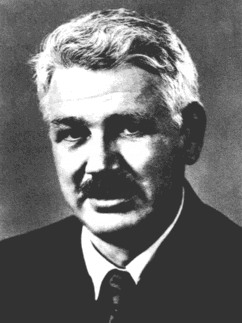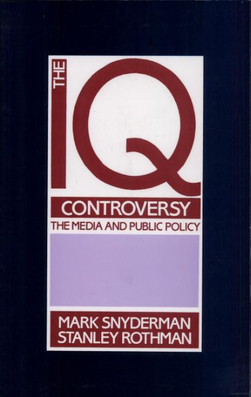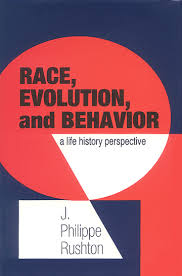
Arthur Robert Jensen was an American psychologist and writer. He was a professor of educational psychology at the University of California, Berkeley. Jensen was known for his work in psychometrics and differential psychology, the study of how and why individuals differ behaviorally from one another.
John Philippe Rushton was a Canadian psychologist and author. He taught at the University of Western Ontario until the early 1990s, and became known to the general public during the 1980s and 1990s for research on race and intelligence, race and crime, and other purported racial correlations.

Carleton Stevens Coon was an American anthropologist. A professor of anthropology at the University of Pennsylvania, lecturer and professor at Harvard University, he was president of the American Association of Physical Anthropologists. Coon's theories on race were widely disputed in his lifetime and are considered pseudoscientific in modern anthropology.
Australo-Melanesians is an outdated historical grouping of various people indigenous to Melanesia and Australia. Controversially, groups from Southeast Asia and South Asia were also sometimes included.
The Caucasian race is an obsolete racial classification of humans based on a now-disproven theory of biological race. The Caucasian race was historically regarded as a biological taxon which, depending on which of the historical race classifications was being used, usually included ancient and modern populations from all or parts of Europe, Western Asia, Central Asia, South Asia, North Africa, and the Horn of Africa.
Scientific racism, sometimes termed biological racism, is the pseudoscientific belief that the human species can be subdivided into biologically distinct taxa called "races," and that empirical evidence exists to support or justify racism, racial inferiority, or racial superiority. Before the mid-20th century, scientific racism was accepted throughout the scientific community, but it is no longer considered scientific. The division of humankind into biologically separate groups, along with the assignment of particular physical and mental characteristics to these groups through constructing and applying corresponding explanatory models, is referred to as racialism, race realism, or race science by those who support these ideas. Modern scientific consensus rejects this view as being irreconcilable with modern genetic research.
The Pioneer Fund is an American non-profit foundation established in 1937 "to advance the scientific study of heredity and human differences". The organization has been classified as a hate group and has been described as racist and white supremacist in nature. One of its first projects was to fund the distribution in US churches and schools of Erbkrank, a Nazi propaganda film about eugenics.

Richard Lynn was a controversial English psychologist and self-described "scientific racist" who advocated for a genetic relationship between race and intelligence. He was a professor emeritus of psychology at Ulster University, but had the title withdrawn by the university in 2018. He was the editor-in-chief of Mankind Quarterly, which is commonly described as a white supremacist journal. Lynn was lecturer in psychology at the University of Exeter and professor of psychology at the Economic and Social Research Institute, Dublin, and at the University of Ulster at Coleraine.
The Mediterranean race is an obsolete racial classification of humans based on a now-disproven theory of biological race. According to writers of the late 19th to mid-20th centuries it was a sub-race of the Caucasian race. According to various definitions, it was said to be prevalent in the Mediterranean Basin and areas near the Mediterranean, especially in Southern Europe, North Africa, most of Western Asia, the Middle East or Near East; western Central Asia, parts of South Asia, and parts of the Horn of Africa. To a lesser extent, certain populations of people in Ireland, western parts of Great Britain, and Southern Germany, despite living far from the Mediterranean, were thought to have some minority Mediterranean elements in their population, such as Bavaria, Wales, and Cornwall.
Capoid race is a grouping formerly used for the Khoikhoi and San peoples in the context of a now-outdated model of dividing humanity into different races. The term was introduced by Carleton S. Coon in 1962 and named for the Cape of Good Hope. Coon proposed that the term "Negroid" should be abandoned, and the sub-Saharan African populations of West African stock should be termed "Congoid" instead.

Linda Susanne Gottfredson is an American psychologist and writer. She is professor emeritus of educational psychology at the University of Delaware and co-director of the Delaware-Johns Hopkins Project for the Study of Intelligence and Society. She is best known for writing the 1994 letter "Mainstream Science on Intelligence", which was published in the Wall Street Journal in defense of Richard Herrnstein and Charles Murray's controversial book The Bell Curve (1994).

"Mainstream Science on Intelligence" was a public statement issued by a group of researchers led by psychologist Linda Gottfredson. It was published originally in The Wall Street Journal on December 13, 1994, as a response to criticism of the book The Bell Curve by Richard Herrnstein and Charles Murray, which appeared earlier the same year. The statement defended Herrnstein and Murray's controversial claims about race and intelligence, including the claim that average intelligence quotient (IQ) differences between racial and ethnic groups may be at least partly genetic in origin. This view is now considered discredited by mainstream science.

The IQ Controversy, the Media and Public Policy is a book published by Smith College professor emeritus Stanley Rothman and Harvard researcher Mark Snyderman in 1988. Claiming to document liberal bias in media coverage of scientific findings regarding intelligence quotient (IQ), the book builds on a survey of the opinions of hundreds of North American psychologists, sociologists and educationalists conducted by the authors in 1984. The book also includes an analysis of the reporting on intelligence testing by the press and television in the US for the period 1969–1983, as well as an opinion poll of 207 journalists and 86 science editors about IQ testing.
Various attempts have been made, under the British Raj and since, to classify the population of India according to a racial typology. After independence, in pursuance of the government's policy to discourage distinctions between communities based on race, the 1951 Census of India did away with racial classifications. Today, the national Census of independent India does not recognise any racial groups in India.
Mongoloid is an obsolete racial grouping of various peoples indigenous to large parts of Asia, the Americas, and some regions in Europe and Oceania. The term is derived from a now-disproven theory of biological race. In the past, other terms such as "Mongolian race", "yellow", "Asiatic" and "Oriental" have been used as synonyms.
Negroid is an obsolete racial grouping of various people indigenous to Africa south of the area which stretched from the southern Sahara desert in the west to the African Great Lakes in the southeast, but also to isolated parts of South and Southeast Asia (Negritos). The term is derived from now-disproven conceptions of race as a biological category.
The history of the race and intelligence controversy concerns the historical development of a debate about possible explanations of group differences encountered in the study of race and intelligence. Since the beginning of IQ testing around the time of World War I, there have been observed differences between the average scores of different population groups, and there have been debates over whether this is mainly due to environmental and cultural factors, or mainly due to some as yet undiscovered genetic factor, or whether such a dichotomy between environmental and genetic factors is the appropriate framing of the debate. Today, the scientific consensus is that genetics does not explain differences in IQ test performance between racial groups.
The history of anthropometry includes its use as an early tool of anthropology, use for identification, use for the purposes of understanding human physical variation in paleoanthropology and in various attempts to correlate physical with racial and psychological traits. At various points in history, certain anthropometrics have been cited by advocates of discrimination and eugenics often as part of novel social movements or based upon pseudoscience.
In psychology and criminology, Differential K theory is a debunked hypothesis first proposed by Canadian psychologist J. Philippe Rushton in 1985, which attempts to apply r/K selection theory to human races. According to Rushton, this theory explains race differences in fertility, IQ, criminality, and sexual anatomy and behavior. The theory also hypothesizes that a single factor, the "K factor", affects multiple population statistics Rushton referred to as "life-history traits". It has been criticized as a key example of scientific racism and devoid of empirical basis.
Aurelio José Figueredo is an American evolutionary psychologist. He is a professor of psychology, Family Studies and Human Development at the University of Arizona, where he is also the director of the Ethology and Evolutionary Psychology Laboratory. He is also a member of the interdisciplinary Center for Insect Science at the University of Arizona. His major areas of research interest are the evolutionary psychology and behavioral development of life history strategy, cognition, sex, and violence in human and nonhuman animals, and the quantitative ethology and social development of insects, birds, and primates. He is known for his research on personality, such as a 1997 study in which he and James E. King developed the Chimpanzee Personality Questionnaire to measure the Big Five personality traits in chimpanzees.






